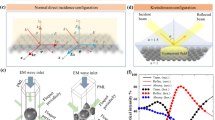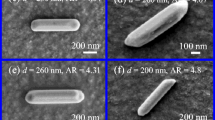Abstract
Well-oriented zinc oxide nanorods arrays (ZnO NRsA) have been grown on seeded substrates. The morphology, chemical, and vibrational characteristics of the nanostructures were investigated. The dependency of the photocurrent of Au decorated ZnO NRsA on wavelength was evaluated by photogain response. Due to the induced surface plasmon excitation, selective response to green laser was observed. An analytical dispersion formalism was constructed to fit the experimental absorption spectrum of both ZnO NRsA and Au-decorated ZnO NRsA, over a wide spectrum range in order to evaluate the bandgap energy, subband tailing, dielectric constant and carrier effective mass and density, and nonlinear optical parameters. The proposed model exploits the Forouhi–Bloomer (FB) parameterization and Gaussian oscillator dispersion for the complex dielectric function of Au-decorated ZnO NRsA. Both the sharp variation in the optical absorption around the band edge and absorption behavior beyond the bandgap energy are covered well. It is surprising that the surface plasmon resonance (SPR) is included without introducing a new formalism. The photogain study on ZnO NRsA-Au 40 nm heterostructure shows that the obtained ESPR from the dispersion model is in complete agreement with the selective green response of the heterostructure. Furthermore, the new model was satisfactorily tested on the optical absorption spectra of CuO thin films.







Similar content being viewed by others
Data Availability
The datasets generated during and/or analyzed during the current study are not publicly available due to other group members ongoing projects on related subjects, but are available from the corresponding author on reasonable request.
References
Forouhi AR, Bloomer I (2019) New dispersion equations for insulators and semiconductors valid throughout radio-waves to extreme ultraviolet spectral range. J. Phys. Commun. 3:035022
Li Z, Lin SH, Qiu GM, Wang JY, Yu YP (2018) A method for determining band parameters from the optical absorption edge of amorphous semiconductor Application to a-Si:H. J Appl Phys 124:025702
Franta D, Cermak M, Vohanka J, Ohlidal I (2017) Dispersion models describing interband electronic transitions combining Tauc’s law and Lorentz model. Thin Solid Films 631:12–22
Likhachev DV, Malkova N, Poslavsky L (2015) Modified Tauc-Lorentz dispersion model leading to a more accurate representation of absorption features below the bandgap. Thin Solid Films 589:844–851
Kumar A, Kumar A, Srivastava SK (in press) Silicon nitride-BP-based surface plasmon resonance highly sensitive biosensor for virus SARS-CoV-2 detection. Plasmonics. https://doi.org/10.1007/s11468-021-01589-1
Sagar P, Srivastava M, Prakashb R, Srivastava SK (2020) The fabrication of an MoS2 QD–Au NP modified screen-printed electrode for the improved electrochemical detection of cefixime. Anal Methods 12:3014–3024
Campi D, Coriasso C (1988) Prediction of optical properties of amorphous tetrahedrally bonded materials. J Appl Phys 64(8):4128–4134
Jellison GE, Modine FA (1996) Parameterization of the optical functions of amorphous materials in the interband region. Appl Phys Lett 69(3):371–373
Cody GD (1984) Semiconductors and semimetals. Vol. 21
Rodriguez- De Marcos LV, Larruquert JI (2016) Analytic optical-constant model derived from Tauc-Lorentz and Urbach tail. Opt Express 24(25):28561
Foldyna M, Postava K, Bouchala J, Pitora J, Yamaguchi T (2003) Model dielectric function of amorphous materials including Urbach tail. Proc SPIE 5445:301–305
Ferlauto AS, Koh J, Rovira PI, Wronski CR, Collins RW, Ganguly G (2000) Modeling the dielectric functions of silicon-based films in the amorphous, nanocrystalline and microcrystalline regimes. J Non-Cryst Solids 266–269:269–273
Franta D, Ohlídal I, Nečas D, Vižd’a F, Caha O, Hasoň M, Pokorný P (2011) Optical characterization of HfO2 thin films. Thin Solid Films 519:6085–6091
Ferlauto AS, Ferreira GM, Pearce JM, Wronski CR, Collins RW, Deng X, Ganguly G (2004) Analytical model for the optical functions of amorphous semiconductors and its applications for thin film solar cells. Thin Solid Films 455–456:388–392
Mei JJ, Chen H, Shen WZ, Dekkers HFW (2006) Optical properties and local bonding configurations of hydrogenated amorphous silicon nitride thin films. J Appl Phys 100:073516
Shahi N, Rahmati A (2019) Ag Incorporated ZnO Nanorods Array/ZnSe Heterostructure. ECS J Solid State Sci Technol 8(10):Q200–Q206
Rahmati A, Farokhipour A (2019) Rectifying behaviour and photocatalytic activity in ZnO nanorods array/ Ag / CuSe heterostructure. J Cluster Sci 30:521–529
Ghaemi-moghadam M, Hassanzadeh A, Rahmati A (2021) Charge transfer plasmon coupled surface photosensing in ZnO nanorods–Au array hetero-nanostructures. Opt Lasers Eng 137:106384
Fox M(2010) Optical properties of solids, Second Edition. Oxford University Press, page 39
Fujiwara H, Kondo M (2005) Effects of carrier concentration on the dielectric function of ZnO: Ga and In2O3: Sn studied by spectroscopic ellipsometry: analysis of free-carrier and band-edge absorption. Phys Rev B 71:075109
Kumar A, Kumar A, Kushwaha AS, Dubey SK, Srivastava SK (2022) A comparative study of different types of sandwiched structures of SPR biosensor for sensitive detection of ssDNA. Photonics Nanostruct Fundam Appl 48:100984
De Sousa Meneses D, Malki M, Echegut P (2006) Structure and lattice dynamics of binary lead silicate glasses investigated by infrared spectroscopy. J Non-Cryst Solids 352:769–776
Akaltun Y, Yıldırım MA, Ateş A, Yıldırım M (2012) Zinc concentration effect on structural, optical and electrical properties of Cd1−x ZnxSe thin films. Mater Ress Bull 47:3390–3396
Mezrag F, Mohamed WK, Bouarissa N (2010) The effect of zinc concentration upon optical and dielectric properties of Cd1−xZnxSe. Physica B 405:2272–2276
Herve P, Vandamme LKJ (1994) General relation between refractive index and energy gap in semiconductors. Infrared Phys Technol 35:609–615
Dimitrov V, Sakka S (1996) Linear and nonlinear optical properties of simple oxides. II. J Appl Phys 79(3):1741–1745
Hannachi L, Bouarissa N (2009) Band parameters for cadmium and zinc chalcogenide compounds. Physica B 404:3650–3654
Tiwari P, Jaiswal J, Chandra R (2019) Optical and electrical properties of highly ordered α-, γ- and α + γ-MnS films deposited by reactive sputtering technique. J Appl Phys 126:213108
Hassanieh AS, Aly KA, Akl AA (2016) Study of optical properties of thermally evaporated ZnSe thin films annealed at different pulsed laser power. J Alloy Compd 685:733–742
Gupta V, Bhattacharya P, Yuzuk YI, Sreenivas K, Katiyar RS (2006) Optical phonon modes in ZnO nanorods on Si prepared by pulsed laser deposition. J Cryst Growth 287:39–43
Alim K, Fonoberov VA, Shamsa M, Balandin AA (2005) Micro-Raman investigation of optical phonons in ZnO quantum dots. J Appl Phys 97:124313
Sagar P, Gupta GK, Srivastava M, Srivastavab A, Srivastava SK (2021) Tagetes erecta as an organic precursor: synthesis of highly fluorescent CQDs for the micromolar tracing of ferric ions in human blood serum. RSC Adv 11:19924–19934
Murakami H, Takarada T, Tonouchi M (2020) Low temperature GaAs based plasmonics photoconductive terahertz detector with au nanoislands. Photonics Res 8:1448–1456
Rahmati A, Rahmani B, Farokhipour A (2018) Hetero plasmonic 2D and 3D ZnO/Ag nanostructures: electrical and photocatalytic applications. J Mater Sci Mater Electron 29:6350–6360
Baxter JB, Schmuttenmaer CA (2006) Conductiviy of ZnO nanowire, nanoparticles, and thin films using time-resolved terahertz spectroscopy. Journal Phys Chem B 110:25229–25239
Akaltun Y (2015) Effect of thickness on the structural and optical properties of CuO thin films grown by successive ionic layer adsorption and reaction. Thin Solid Films 594:30–34
Author information
Authors and Affiliations
Contributions
All authors contributed to the study conception and design. Material preparation, data collection, and analysis were performed by Mahla Ghaemi-moghadam, Abdollah Hassanzadeh, and Ali Rahmati. The first draft of the manuscript was written by Mahla Ghaemi-moghadam under supervision of Abdollah Hassanzadeh and Ali Rahmati. All authors commented on previous versions of the manuscript. All authors read and approved the final manuscript.
Corresponding author
Ethics declarations
Ethics Approval
Not applicable.
Consent to Participate
Not applicable.
Consent to Publish
Not applicable.
Competing Interests
The authors declare no competing interests.
Additional information
Publisher's Note
Springer Nature remains neutral with regard to jurisdictional claims in published maps and institutional affiliations.
Rights and permissions
About this article
Cite this article
Ghaemi-moghadam, M., Hassanzadeh, A. & Rahmati, A. Surface Plasmon Resonance and Absorption Features Beyond the Bandedge in ZnO Nanorods Array – Au Heterostructures: Prediction and More Accurate Representation. Plasmonics 17, 1345–1354 (2022). https://doi.org/10.1007/s11468-022-01632-9
Received:
Accepted:
Published:
Issue Date:
DOI: https://doi.org/10.1007/s11468-022-01632-9




